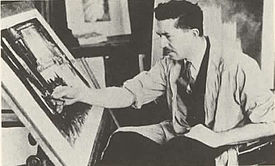Hugh Ferriss

Hugh Ferriss (1889 – 1962) was an American delineator (one who creates drawings and sketches of buildings) and architect. After his death a colleague said he 'influenced my generation of architects' more than any other man. Ferriss also influenced popular culture, for example Gotham City (the setting for Batman) and Kerry Conran's Sky Captain and the World of Tomorrow.
Biography

Ferriss was trained as an architect at Washington University in his native St. Louis, Missouri, but, early in his career, he began to specialize in creating architectural renderings for other architects' work rather than designing buildings himself. As a delineator, his task was to create a perspective drawing of a building or project. This was done either as part of the sales process for a project, or, more commonly, to advertise or promote the project to a wider audience. Thus, his drawings were frequently destined for annual shows or advertisements. As a result of this, his works were often published (rather than just given to the architect’s client), and Ferriss acquired a reputation. After he had set up as a free-lance artist, he found himself much sought after.
In 1912, Ferriss arrived in New York City and was soon employed as a delineator for Cass Gilbert. Some of his earliest drawings are of Gilbert’s Woolworth Building; they reveal that Ferriss’s illustrations had not yet developed his signature dark, moody appearance. In 1915, with Gilbert’s blessing, he left the firm and set up shop as an independent architectural delineator. In 1914, Ferriss married Dorothy Lapham, an editor and artist for Vanity Fair.

By 1920, Ferriss had begun to develop his own style, frequently presenting the building at night, lit up by spotlights, or in a fog, as if photographed with a soft focus. The shadows cast by and on the building became almost as important as the revealed surfaces. His style elicited emotional responses from the viewer. His drawings were being regularly featured by such diverse publications as the Century Magazine, the Christian Science Monitor, Harper's Magazine, and Vanity Fair. His writings also began to appear in various publications.
In 1916, New York City had passed landmark zoning laws that regulated and limited the massing of buildings according to a formula. The reason was to counteract the tendency for buildings to occupy the whole of their lot and go straight up as far as was possible. Since many architects were not sure exactly what these laws meant for their designs, in 1922 the skyscraper architect Harvey Wiley Corbett commissioned Ferriss to draw a series of four step-by-step perspectives demonstrating the architectural consequences of the zoning law. These four drawings would later be used in his 1929 book The Metropolis of Tomorrow. This book illustrated many conte crayon sketches of tall buildings. Some of the sketches were theoretical studies of possible setback variations within the 1916 zoning laws. Some were renderings for other architect's skyscrapers. And at the end of the book was a sequence of views in Manhattan emerged in an almost Babylonian guise.
Hugh Ferriss's archive, including drawings and papers, is held by the Drawings & Archives Department of the Avery Architectural and Fine Arts Library at Columbia University. Every year, the American Society of Architectural Illustrators gives out the Hugh Ferriss Memorial Prize for architectural rendering excellence. The medal features Ferriss’s original "Fourth Stage" drawing, executed in bronze. In 1955, he was elected into the National Academy of Design as an Associate member, and became a full Academician in 1960.
Selected renderings
- The Liberty Memorial, Kansas City, Missouri. Harold Van Buren Magonigle, architect.
- The Four Stages
- Chicago Tribune Tower. Howells & Hood, architects.
- Players Club, Detroit, Michigan. Smith Hinchman & Grylls [SH&G], architects.
- Radiator Building, New York, New York. Raymond Hood, architect.
- Buhl Building, Detroit, Michigan. Smith Hinchman & Grylls [SH&G], architects.
- Chicago Board of Trade Building. Holabird & Root, architects.
- Penobscot Building, Detroit, Michigan. Smith Hinchman & Grylls [SH&G], architects.
- Guardian [Union Trust] Building, Detroit, Michigan. Smith Hinchman & Grylls [SH&G], architects.
- Telephone Building, St. Louis, Missouri. Mauran, Russell & Crowell and Timlin, architects.
References
- William J Curtis Modern architecture since 1900' Third edition
- Balfour, Alan. Rockefeller Center – Architecture As Theater. New York: McGraw-Hill Book Company, 1978. ISBN 0-07-003480-X.
- Hoak & Church. Masterpieces of American Architecture Mineola, New York: Dover Publications, 2002. Reprint of 1930 edition by Charles Scribner. ISBN 0-486-42231-3.
- Ferriss, Hugh. The Metropolis of Tomorrow, with essay by Carol Willis. New York: Princeton Architectural Press, 1986. Reprint of 1929 edition. ISBN 0-910413-11-8.
- Ferriss, Hugh. Power in Buildings, An Artist’s View of Contemporary Buildings. New York: Columbia University Press, 1953.
- Ferriss, Hugh. American Capitals of Industry: A Series of Drawings by Hugh Ferriss. Harpers Magazine, July 1919.
- Holleman & Gallagher. Smith Hinchman & Grylls, 125 Years of Architecture and Engineering, 1853–1978. Detroit: Wayne State University Press, 1978. OCLC 4136542.
- Kvaran. Architectural Sculpture of America, unpublished manuscript
- Stern, Gilmartin & Mellins. New York 1930: Architecture and Urbanism Between the Two World Wars. New York: Rizzoli International Publications, 1987. ISBN 0-8478-0618-9.
- Tottis, James W. (2008). The Guardian Building: Cathedral of Finance. Wayne State University Press. ISBN 978-0-8143-3385-3.
- Willis, Carol. Hugh Ferriss: Metropolis. Exhibition organized by the Architectural League of New York, 1986.
External links
- The Hugh Ferriss Architectural Drawings and Papers Collection. Includes digital images of more than 350 original drawings held by Columbia University.
